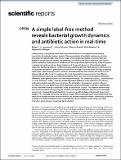A simple label-free method reveals bacterial growth dynamics and antibiotic action in real-time
Date
12/11/2022Metadata
Show full item recordAbstract
Understanding the response of bacteria to environmental stress is hampered by the relative insensitivity of methods to detect growth. This means studies of antibiotic resistance and other physiological methods often take 24 h or longer. We developed and tested a scattered light and detection system (SLIC) to address this challenge, establishing the limit of detection, and time to positive detection of the growth of small inocula. We compared the light-scattering of bacteria grown in varying high and low nutrient liquid medium and the growth dynamics of two closely related organisms. Scattering data was modelled using Gompertz and Broken Stick equations. Bacteria were also exposed meropenem, gentamicin and cefoxitin at a range of concentrations and light scattering of the liquid culture was captured in real-time. We established the limit of detection for SLIC to be between 10 and 100 cfu mL−1 in a volume of 1–2 mL. Quantitative measurement of the different nutrient effects on bacteria were obtained in less than four hours and it was possible to distinguish differences in the growth dynamics of Klebsiella pneumoniae 1705 possessing the BlaKPC betalactamase vs. strain 1706 very rapidly. There was a dose dependent difference in the speed of action of each antibiotic tested at supra-MIC concentrations. The lethal effect of gentamicin and lytic effect of meropenem, and slow bactericidal effect of cefoxitin were demonstrated in real time. Significantly, strains that were sensitive to antibiotics could be identified in seconds. This research demonstrates the critical importance of improving the sensitivity of bacterial detection. This results in more rapid assessment of susceptibility and the ability to capture a wealth of data on the growth dynamics of bacteria. The rapid rate at which killing occurs at supra-MIC concentrations, an important finding that needs to be incorporated into pharmacokinetic and pharmacodynamic models. Importantly, enhanced sensitivity of bacterial detection opens the possibility of susceptibility results being reportable clinically in a few minutes, as we have demonstrated.
Citation
Hammond , R , Falconer , K , Powell , T , Bowness , R & Gillespie , S H 2022 , ' A simple label-free method reveals bacterial growth dynamics and antibiotic action in real-time ' , Scientific Reports , vol. 12 , 19393 . https://doi.org/10.1038/s41598-022-22671-6
Publication
Scientific Reports
Status
Peer reviewed
ISSN
2045-2322Type
Journal article
Description
Funding: The authors gratefully acknowledge the financial support of Scottish Enterprise, NESTA Longitude Prize and the University of St Andrews.Collections
Items in the St Andrews Research Repository are protected by copyright, with all rights reserved, unless otherwise indicated.

